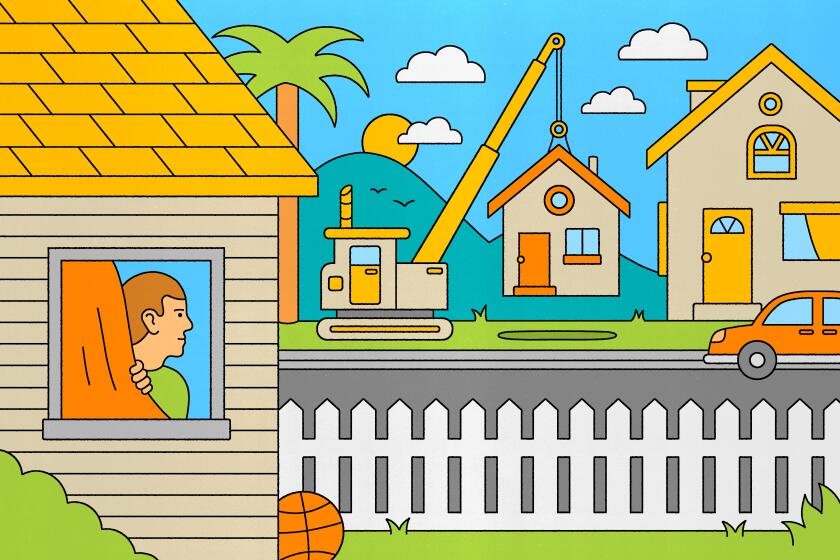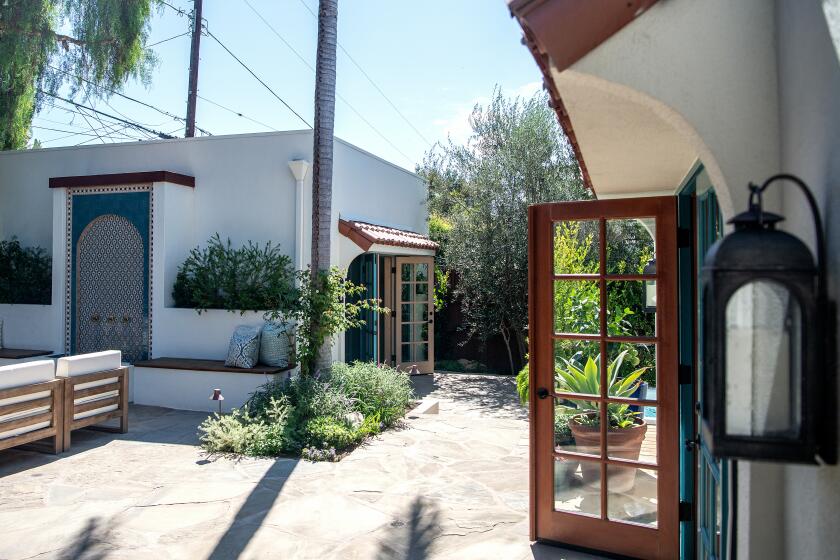What will an ADU do to your property taxes and resale value?

- Share via
A common pitch for accessory dwelling units is that building one will add a lot of value to your property.
How much, though, is a bit of a mystery. And that can pose a problem for homeowners looking to build one.
An ADU isn’t just extra square footage — it’s a complete home, with its own kitchen, bathroom and utilities. You can use it to house family members, caregivers, tenants or even yourself, if you decide to downsize and rent out your current home.
But here’s where things get tricky. You can’t sell your ADU separately, at least not under current state law; instead, it’s just another improvement on your lot, like your main home. If you sell your house, the ADU goes with it.
And when the sale is made, there’s no line in the contract indicating how much the buyer is paying for the ADU. There’s one sale amount for the entire property.
Appraisers say that they estimate the value of an ADU by comparing sales of houses with an accessory unit to other sales in recent months involving houses of similar size, condition and location that don’t have ADUs. But even though ADUs have boomed since the state made it easier to get permits for them in 2017 — more than 20,600 ADUs were built last year alone — there haven’t been many homes with legal ADUs sold. That means appraisers don’t have as much data about comparable sales that they typically have to determine the property value.
Sign up for You Do ADU
Our six-week newsletter will help you make the right decision for you and your property.
You may occasionally receive promotional content from the Los Angeles Times.
For example, according to Zillow, 642 houses with about 2,000 square feet of living space sold in Los Angeles over the last three months, but only 106 of the listings included an ADU.
That’s why there are different ways to estimate the value of an ADU — one used by property tax officials, others by lenders and home buyers. And for some homeowners, the former will be higher than the latter.
Small-space living is a big trend in Southern California. Get inspired by these local ADUs and learn how to plan your own build.
ADUs and property taxes
Adding an ADU to your lot will raise your property tax bill. Your house won’t be reassessed, tax officials say, but the value of the ADU will be added to the value of the improvements on your lot.
Stephen R. Whitmore, the public information officer for the L.A. County assessor, said the process of determining the ADU’s value is straightforward: “Our staff will determine the cost to build it.” That cost will be tacked onto your property’s current assessment and taxed annually; the county taxes property at a rate of 1%, and local parcel taxes and other levies increase the toll by roughly 0.25%.
So if you have a house valued at $1 million and spend $200,000 to add an ADU, your annual tax bill will increase by about $2,500, from roughly $12,500 to roughly $15,000.
The first question to ask before deciding on an accessory dwelling unit is, ‘What am I trying to accomplish?’ Then check whether an ADU is the way to achieve that goal.
Loans for an ADU
But what is the value of an ADU that hasn’t been built yet? Lenders need a good estimate for this because it affects the size of the loan they’ll be willing to make.
For example, a Federal Housing Administration-backed renovation loan can be up to 97.75% of the value of property after the ADU is finished, and Fannie Mae supports refinances that cover up to 97% of the post-construction value. Other ways to borrow money for an ADU, such as a home equity loan or line of credit, typically set lower loan-to-value limits, but some go up to 90% of the property value with the ADU.
Lenders rely on professional appraisers to estimate the value added by an ADU. And although Fannie Mae and Freddie Mac have issued guidelines for appraising properties with ADUs, they seem more applicable to existing ADUs than planned ones.
Appraisers typically look at comparable sales when valuing homes, as well as rental income when the properties are rented out. For ADUs, though, real estate pros say there’s no standard approach, at least not yet.
“If we had one or two comparables with ADUs ... our life would be easy,” said Denis DeSaix of Metrocal Appraisal in Livermore. “Finding that one or two comps is challenging because there hasn’t been enough time for the ADUs to work into the regular transaction flow. Ten years from now, we’ll see a lot of them.”
Meredith Stowers, a loan officer at CrossCountry Mortgage in San Diego, said she’s seen an appraiser assign a value of $0 to a 1,200-square-foot, three-bedroom ADU. Appraisals can be adjusted to reflect the marketability of the property, she said, “but you’ve got to ask Realtors [for input] and do some extra research.”
The Federal Housing Administration is proposing to let lenders include future rent from an ADU when calculating how much a borrower can receive in an FHA-guaranteed loan. That would be a major shift.
Anthony Dedousis of Revival Homes, a Los Angeles-based firm that helps homeowners find financing and contractors for their ADU projects, said his company takes a big-data approach to overcome the shortage of ADU sales in individual communities. It collected sales data for single-family homes with ADUs across L.A. County since 2017, then compared it with sales of about 90,000 homes without ADUs. After controlling for factors such as lot size, main house size and ZIP Code, he said, “we find that the typical ADU adds 24% (about $250,000) to the sale price of a single-family home in L.A. County,” with values ranging from 18% to 35% depending on the ADU’s size.
The company uses this statistical model to project the value of a home after an ADU project is completed, which is factored into its lending partner’s calculation of how large a loan to offer. This approach, Dedousis said, makes ADU projects far more feasible for newer homeowners, whose lack of home equity limits their borrowing.
Mortgage Vintage in Newport Beach offers ADU construction loans financed by investors, not traditional lenders, which gives the company more flexibility in its approach to appraisals. Still, its appraisers look at the same things that most appraisers do when valuing property, Chief Executive Sandy MacDougall said: comparable sales, construction costs and potential rental income.
You’ll probably need some kind of loan to help pay for an ADU. Your options will depend on your income, your home equity and your current mortgage.
Evolving approaches
As Stowers noted, the shortage of data has led to some conservative appraisals of ADUs. For example, in a discussion about ADU values in Los Angeles on a BiggerPockets forum in 2020 and 2021, real estate pros said appraisals were coming in well below the cost of building an ADU. “Based on conversations I’ve had with loan officers, for every dollar you spend on an ADU, about 55% (55 cents) goes to the appraisal value,” one investor wrote in 2021.
Stowers said she had two clients who purchased a house in Burbank for $1.3 million, then added a $200,000 ADU. After construction, she said, one appraiser valued the property at $1.4 million — essentially, discounting the ADU’s value by 50%. “My appraisers gave it a value of $1.9 million because of the incredible marketability and rental income” that the ADU offered, Stower said, adding that the property was three blocks from Warner Bros. Studios.
“Having said all that,” she added, “usually my appraisers give dollar-for-dollar value” — in other words, they value ADUs according to their construction cost, the same way the county assessor does.
Jun Ho Lee, an appraiser based in San Gabriel, said he typically finds that ADUs add 10% to 20% to a property’s value. But location affects what an ADU is worth, he said.
“Even if it’s the same quality, same materials, same size,” Lee said, “you cannot give the same value to the ADU located in Beverly Hills and located in Compton.”
Like the government agencies that buy mortgages, the lenders that issue them have a lot of control over how ADUs will be valued. And in DeSaix’s view, lenders are becoming increasingly open to alternative ways to demonstrate value and demand.
Real estate agents and brokers are an excellent source of information, he said, because “they are in the market, in the trenches, buying and selling day in and day out.” Their views may be subjective, but if an appraiser talks to enough of them, they’ll probably get “a pretty reliable idea of a value range” for an ADU.
We want to hear from you
Are you building an ADU or considering one? Do you have insights to share or unanswered questions? Or horror stories? Tell us.
About The Times Utility Journalism Team
This article is from The Times’ Utility Journalism Team. Our mission is to be essential to the lives of Southern Californians by publishing information that solves problems, answers questions and helps with decision making. We serve audiences in and around Los Angeles — including current Times subscribers and diverse communities that haven’t historically had their needs met by our coverage.
How can we be useful to you and your community? Email utility (at) latimes.com or one of our journalists: Jon Healey, Ada Tseng, Jessica Roy and Karen Garcia.
More to Read
Sign up for You Do ADU
Our six-week newsletter will help you make the right decision for you and your property.
You may occasionally receive promotional content from the Los Angeles Times.












